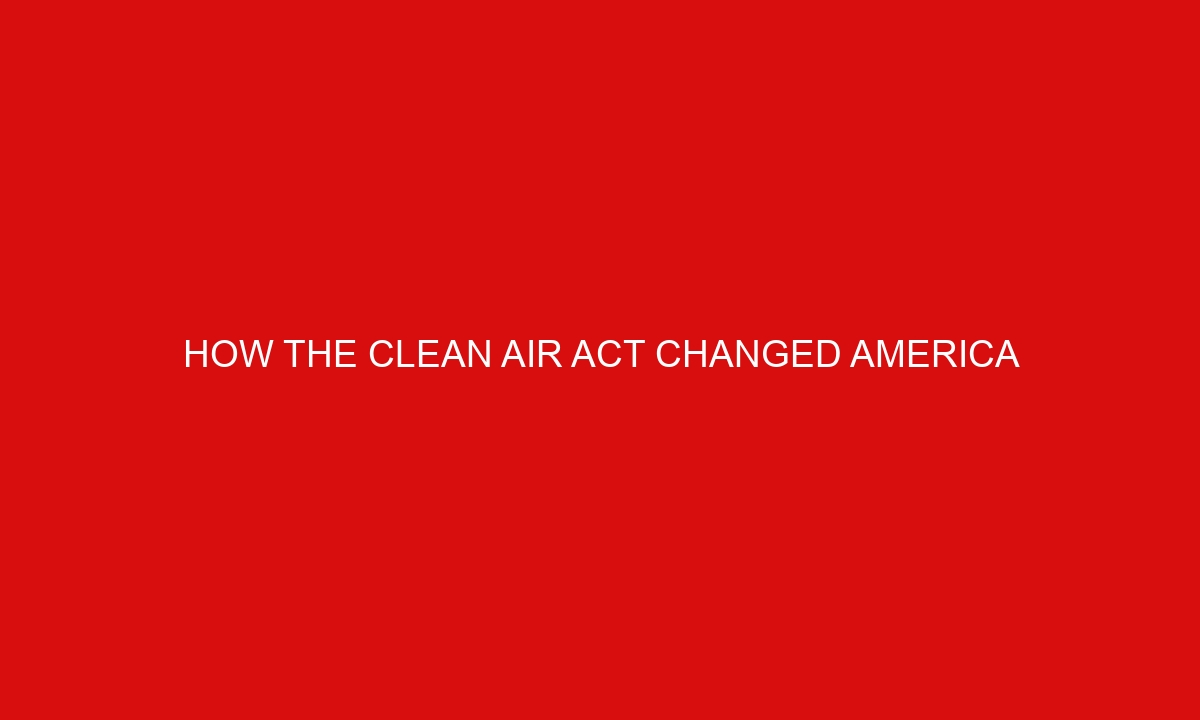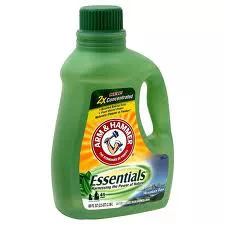How The Clean Air Act Changed America
Written by: Greg Wiszniewski
United States Code section 7401, also known as the Clean Air Act, is a landmark collection of major federal pollution control regulations first signed into law by Lyndon B. Johnson in 1963. This first version of the law was about little more than research and fact-finding. It has since undergone a series of revisions and amendments, most notably in 1970, which created not only actual mandates to control pollution, but also the Environmental Protection Agency (EPA) to interpret and enforce these mandates. It is the creation of the EPA and actual pollution regulations which makes the Clean Air Act of 1970 the most popular name for the Act. Major amendments in 1990, signed into law by President George H. W. Bush, focused on additional problems like ozone-depleting chemicals and acid rain. The 1990 revisions also included provisions allowing citizens to sue entities over violations of the Clean Air Act, and it also mandated gasoline blends which changed for summer weather in order (“summer blend”) to reduce pollution levels. Further amendments in 2003, called the “Clear Skies Act of 2003”, were rejected by Congress.
There are several major elements within the Clean Air Act. These include laws that protect the national parks, automobile and aircraft emissions controls, laws targeting acid rain and sulfur emissions, and reducing ozone-depleting emissions. The Act requires certain companies to obtain permits to operate, levies pollution taxes, and encourages public participation and help in the enforcement of the law. The EPA, the enforcement agency for the Clean Air Act, establishes National Ambient Air Quality Standards by which it judges whether individual regions of the country have met their standards for pollution control. The EPA can issue sanctions and fines to corporations and even state governments for failure to meet its pollution control goals. To prevent this from happening, states have developed State Implementation Plans (SIPs) in order to develop a road map to achieving compliance with the Clean Air Act as interpreted by the EPA. The EPA works to phase out toxic chemicals that can feasibly be replaced by non-toxic alternatives, and to reduce other toxic and polluting chemicals. It is also dedicated to reducing global warming.
The Clean Air Act has had a significant impact on businesses. For instance, energy companies have been directed to reduce the amount of pollution that they emit into the atmosphere. To comply with stricter EPA pollution regulations, auto manufacturers fitted new cars with catalytic converters to reduce automobile emissions, starting in 1975. The law establishes physical regions around the country, each of which has its own standards and limits on pollution levels. The law also addresses the issue of noise pollution. Overall, these regulations have made it more expensive for companies to operate, especially small businesses. In many cases, companies must purchase permits in order to build facilities that produce heavy pollution. Automobile and airplane manufacturers, and other types of businesses, have faced increasingly stringent emissions control regulations. The Clean Air Act, however, offers some provisions for aid for certain small businesses to help them comply. Despite the additional regulatory burdens that come with enforcing the Act, the cost of electricity, for instance, has gone down despite the upward price pressures of inflation and the amount of pollution regulations that govern energy production.
Keep Your Office Spotless with Our Free Office Cleaning Checklist!
Want to make sure you’re covering all the essential cleaning tasks? Our comprehensive guide covers all essential cleaning tasks, from daily tidying to deep cleaning tips. Make sure no spot is missed and create a healthier, more organized workspace today!
The benefits of the Clean Air Act have in many cases been obvious and dramatic. For example, while the population of the United States has increased since 1970, overall air pollution has decreased. The phasing out of lead in gasoline and paint has helped to reduce lead pollution by over 90 percent since 1980. Between 1980 and 2008, ground-level ozone has decreased by 25 percent, sulfur dioxide has decreased by 71 percent, and nitrogen dioxide has been reduced by 46 percent. In addition, mercury is down by 45 percent from its levels in 1990, and from 1990 to 2012, and carbon monoxide was reduced by 83 percent. According to the White House, this has also had a measurable economic benefit when it comes to reducing health care costs. 160,000 lives were saved in 2010 by the Clean Air Act’s pollution control regulations. Without these pollution laws, 100,000 more hospital visits would have occurred. Studies also show that between the years of 1970 and 1990, the Clean Air Act has saved a total of 22 trillion dollars in health care costs, and prevented a loss of 22 million collective days of work. The law has also led to reductions in city smog, which plagues big cities like Los Angeles and New York. The cost society paid to comply with the new pollution laws is estimated to be around half a trillion dollars. The benefits for nature are also measurable. Forests previously damaged by decades of sulfur (acid) rain have started to recover, and according to the National Wildlife Federation, it has also led to a reduction in the deaths of various animals as a result of pollution. The EPA is now expanding its efforts to combat global warming, which is another consequence of pollutants that human activity is releasing into the atmosphere.
The Clean Air Act and Amendments
- The Plain English Guide to the Clean Air Act: This PDF brochure gives a layman’s analysis of the Clean Air Act. In addition to pointing out why air pollution is a problem, it explains the creation of the first federal Clean Air Act in 1963, and the revisions in 1970 which created the Environmental Protection Agency to provide meaningful enforcement of the law. The brochure also includes a summary of the law, how the law works, and ways to cut back on pollution.
- Clean Air Act Requirements and History: Visitors to this EPA web page will find a summary of the 1970 version of the Clean Air Act. It covers common pollutants and how the law seeks to control them, as well as other pollution issues that Congress has sought to address. In addition there are links to numerous other topics, including the Act’s impact on the economy and its history.
- Clean Air Act: A Summary of the Act and Its Major Requirements: A PDF document by the State Department that summarizes the Clean Air Act. Visitors will find information on air quality standards, implementation and enforcement of the Act, solid waste disposal, and issues concerning the protection of the ozone layer.
- Clean Air Act And Regulations: The National Park Service maintains a web page that gives information about the Clean Air Act’s impact on national parks. It explains the effects of pollution on national parks and gives a short summary of how the law works. The National Park Service’s role in working with regulators to protect national parks is another subject that this page covers.
- Clean Air Act (1970): This Princeton article covers several aspects of the Clean Air Act. These include the history of the law, as well as components, acid rain, and winter versus summer-blend gasoline. Pollution leaks, interstate pollution, emissions trading, and ozone depletion are also issues that visitors can read about on this page.
Impact on Businesses
- 1990 Clean Air Act Amendments – Impact On Small Business: The Illinois Periodicals Online Project produced a document which concentrates on the Clean Air Act amendments signed into law by President George H. W. Bush in 1990, and their impact on businesses. Readers will find information about Title I (Non-Attainment Provisions), Title III (Hazardous Air Pollutants Provisions), and Title V (Operating Permit Programs). It also covers the impact that the law would have on small businesses, as well as Federal programs to help businesses comply with the new regulations.
- The Impact of the Clean Air Act Amendments of 1990 on Electric Utilities and Coal Mines: Evidence from the Stock Market: This PDF article is a study on the impact of the Clean Air Act on the energy industry and the stock market. The study also looks at the stocks of 35 different energy companies and their reactions to President George H. W. Bush’s 1990 amendments to the Act.
- The Benefits and Costs of the Clean Air Act from 1990 to 2020: This PDF document seeks to answer questions about the costs and benefits of modern environmental regulations. It covers the projected economic costs of the Clean Air Act in actual dollars, as well as the economic benefits, also measured in actual dollars, that society gains.
Impact on Pollution
- Red Cedar Tree Study Shows That Clean Air Act Is Reducing Pollution, Improving Forests: This Kansas State University article refers to a study by the Proceedings of the National Academy of Sciences of the United States of America. This study uses analyses of various red cedar trees to show that the Clean Air Act has reduced acid rain and harmful sulfur emissions. Specifically, the report claims that ecosystems have recovered as a direct result of emissions reductions.
- What Has the Clean Air Act Done for Us Lately?: The Union of Concerned Scientists has a brief list of the benefits of the Clean Air Act on this web page. Included are statistics on the reduction of mercury emissions, ozone-depleting chemicals, and the amount of lives that the Act has saved.
- How the Clean Air Act Has Saved $22 Trillion in Health-Care Costs: The Atlantic magazine has published an article that explains the health benefits of the Clean Air Act. The study asserts that pollution control laws have reduced the number of health issues such as heart failure, pneumonia, acute asthma attacks. It shows readers the economic value, in actual dollars, of reducing the occurrence of these issues. Readers can also find out how many premature deaths have been prevented by pollution control regulations. The article also compares benefits to the costs of industries complying with the new laws.
- So What Does the Clean Air Act Do?: The White House offers a defense of the Clean Air Act on its website. Topics covered include lives saved by the Act, the projected number of hospital visits that the Act has prevented, and the amount of pollution that has been removed from the air.
- The Clean Air Act: 40 Years of Protecting Wildlife from Pollution: Visitors to this National Wildlife Federation PDF fact sheet will find information about how the Clean Air Act has benefited animals and the environment. It covers the first 40 years of the Clean Air Act of 1970, from 1970 to 2010, and its impact on public health and the economy. The Act’s benefits for plant life, fish, birds, and various mammal life. The brochure also discusses the threats posed by global warming.
Contact Us
Get a quote
Your satisfaction is our priority, and we’re here to assist. Reach out to Busy Bee effortlessly by contacting us. Whether you have questions, need a custom quote, or want to discuss your cleaning requirements, our friendly team is ready to respond promptly. Connecting with us is the first step towards a cleaner and more comfortable environment for your home or business.
Call us for a quote today!
Contact Us
Get a quote
Your satisfaction is our priority, and we’re here to assist. Reach out to Busy Bee effortlessly by contacting us. Whether you have questions, need a custom quote, or want to discuss your cleaning requirements, our friendly team is ready to respond promptly. Connecting with us is the first step towards a cleaner and more comfortable environment for your home or business.

















